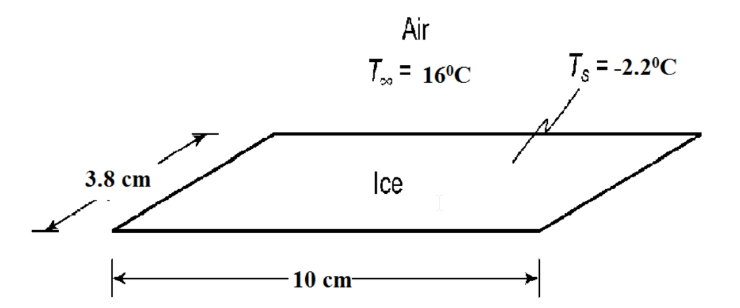A laboratory apparatus is used to maintain a horizontal slab of ice at -2.2°C so that specimens can be prepared on the surface of the ice and kept close to 0°C. If the ice is 10 cm by 3.8 cm and the laboratory is kept at 16°C, find the cooling rate in watts that the apparatus must provide to the ice.
GIVEN
• A slab of ice in a laboratory
• Ice temperature (Ti) = -2.2°C
• Ice dimensions: 10 cm by 3.8 cm
• Ambient temperature (T?) = 16°C
FIND
• The cooling rate (q) in watts
ASSUMPTIONS
• Air in the laboratory is still
• Effects of sublimation are negligible
• Effects of moisture in the air are negligible
SKETCH

PROPERTIES AND CONSTANTS
for dry air at the mean temperature of 6.9°C
Thermal expansion coefficient (?) = 0.0036 1/K
Thermal conductivity (k) = 0.0242 W/(m K)
Kinematic viscosity (?) = 14.51*10-6 m2/s
Prandtl number (Pr) = 0.71
The characteristic length for the ice is

The Grashof and Rayleigh numbers based on this length are

This is a case with very low Rayleigh number, which is below 105 by two orders of magnitude (RaL = 5.6×103), and hence poses a problem for estimating the heat transfer coefficient. For RaL ? 105, the natural convection heat transfer coefficient can be determined from the NuL value predicted. However, that is not the case here and such situations are indeed encountered in engineering practice. Thus an engineering solution can be obtained by extrapolating and extending the applicability so as to use it to predict the Nusselt number even for the low Rayleigh number case, and hence an approximation can be obtained as follows:

The cooling load is

You might also like to view...
A mass on a spring undergoes SHM. When the mass is at maximum displacement from equilibrium, its instantaneous acceleration
A) is a maximum. B) is less than maximum, but not zero. C) is zero. D) cannot be determined without mass information given. E) cannot be determined without spring constant information given.
In a given frictionless displacement of a particle, its kinetic energy increases by 25 J while its potential energy decreases by 10 J. Determine the work of the nonconservative forces acting on the particle during this displacement
a. ?15 J b. +35 J c. +15 J d. ?35 J e. +55 J
The force a spring exerts on a body is a conservative force because
a. a spring always exerts a force opposite to the displacement of the body. b. a spring always exerts a force parallel to the displacement of the body. c. the work a spring does on a body is equal for compressions and extensions of equal magnitude. d. the work a spring does on a body is equal and opposite for compressions and extensions of equal magnitude. e. the net work a spring does on a body is zero when the body returns to its initial position.
According to nebular theory, the progression from planetesimal to full-fledged planet is propelled mainly by which of the following
A. nuclear fusion B. gravity C. heat D. nucleosynthesis